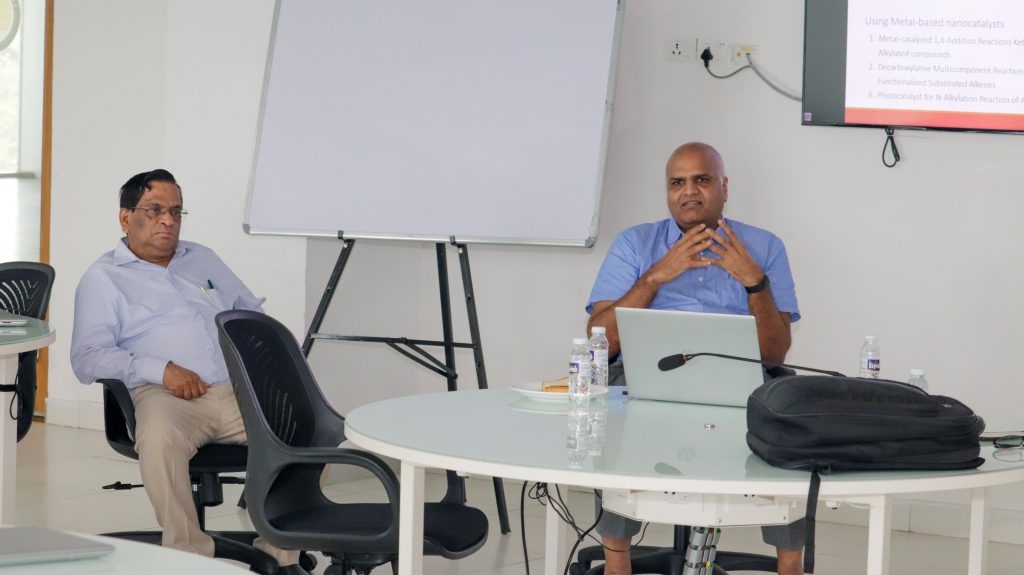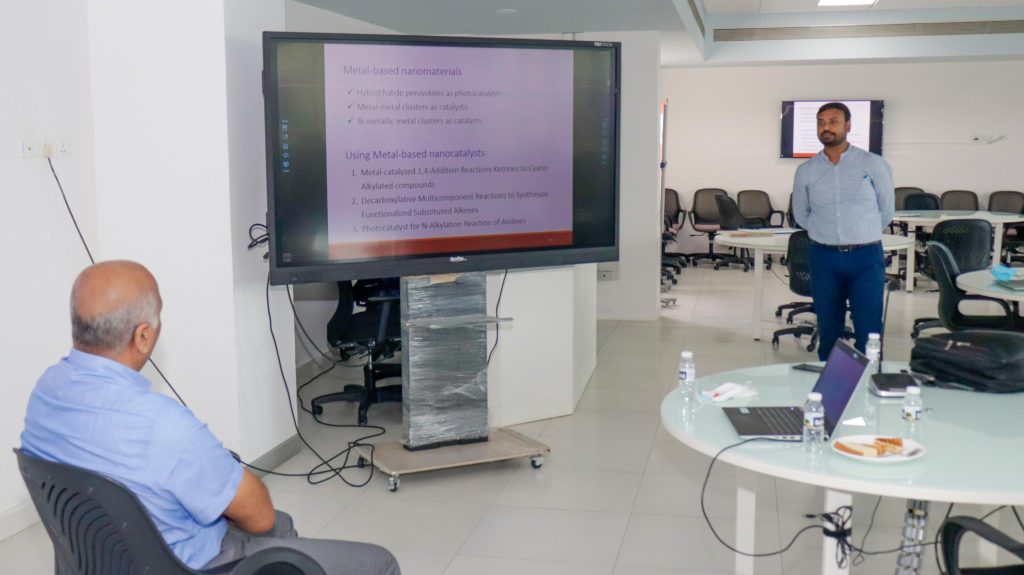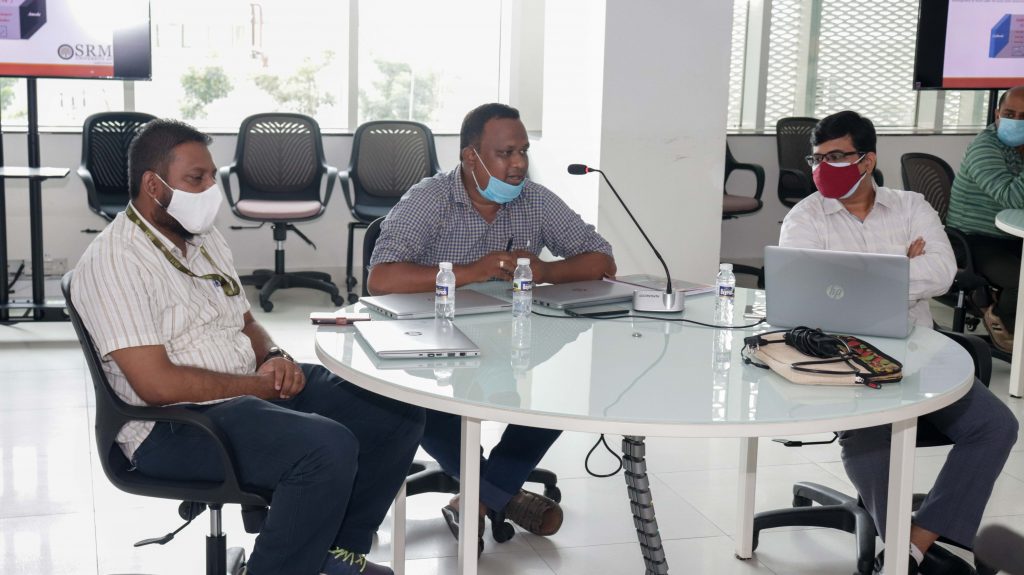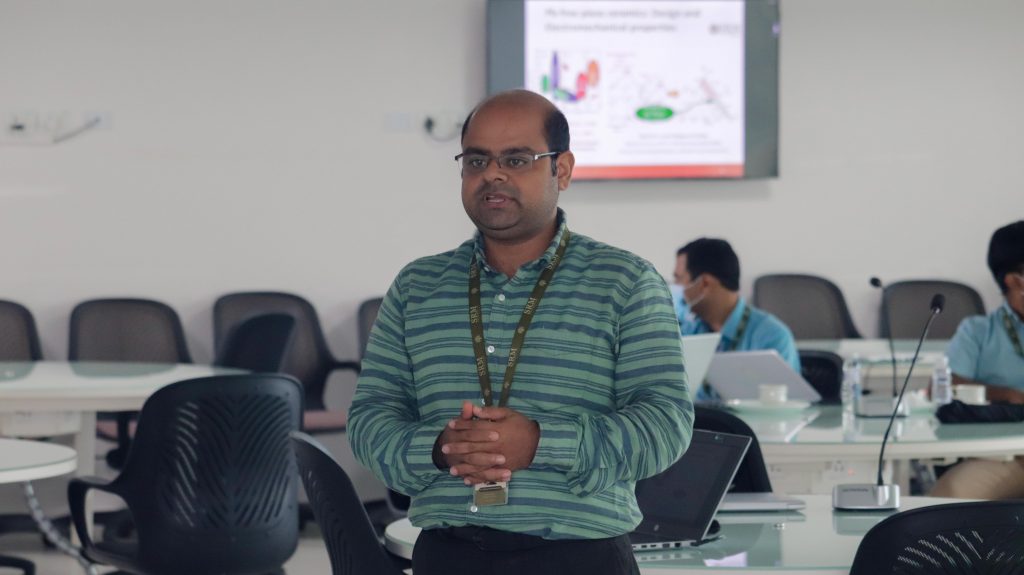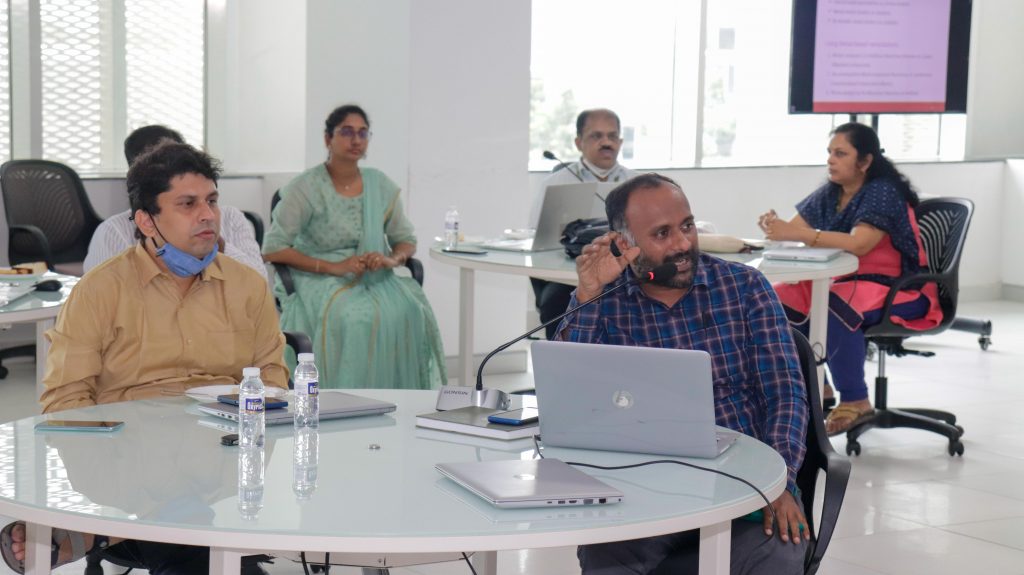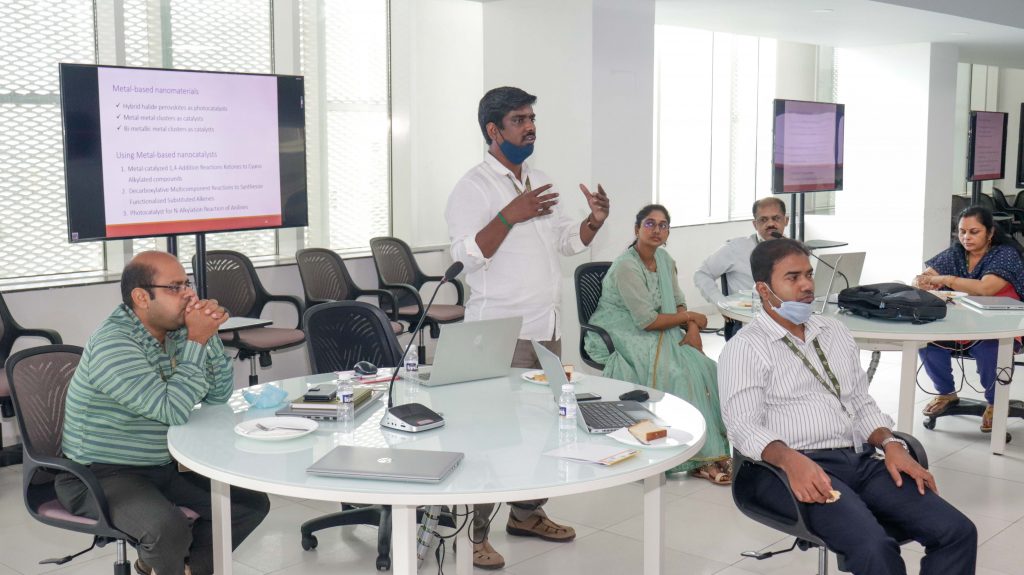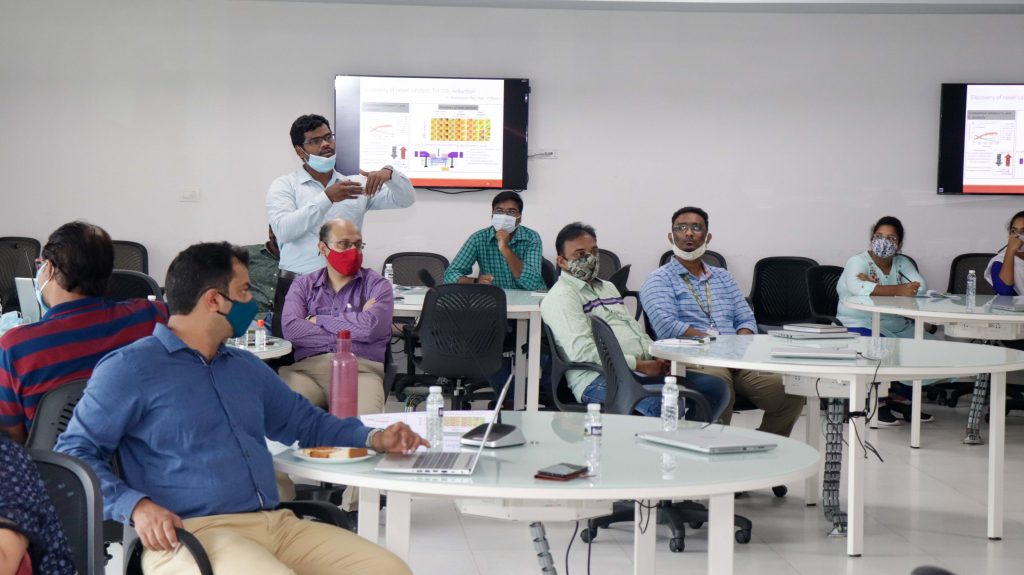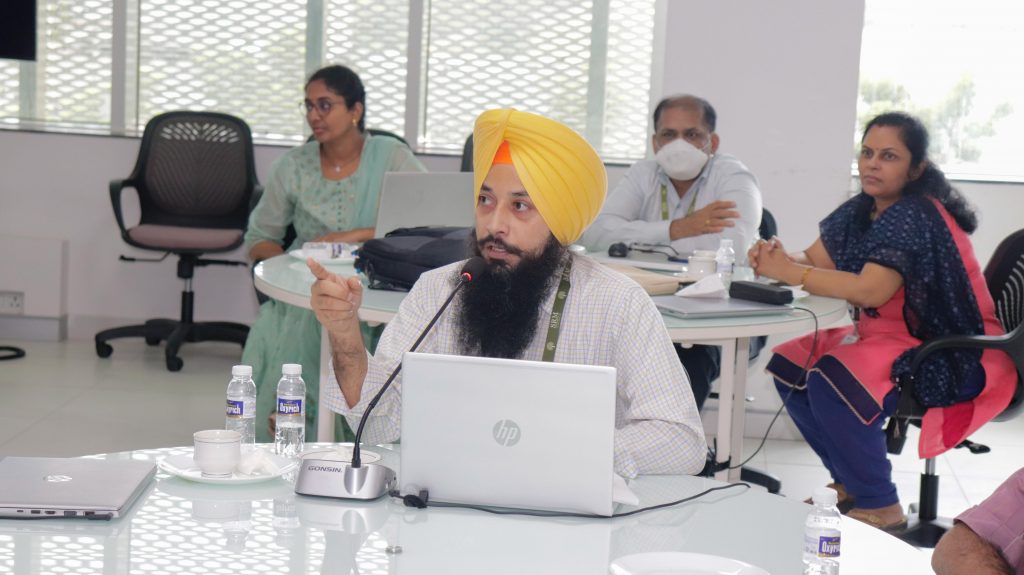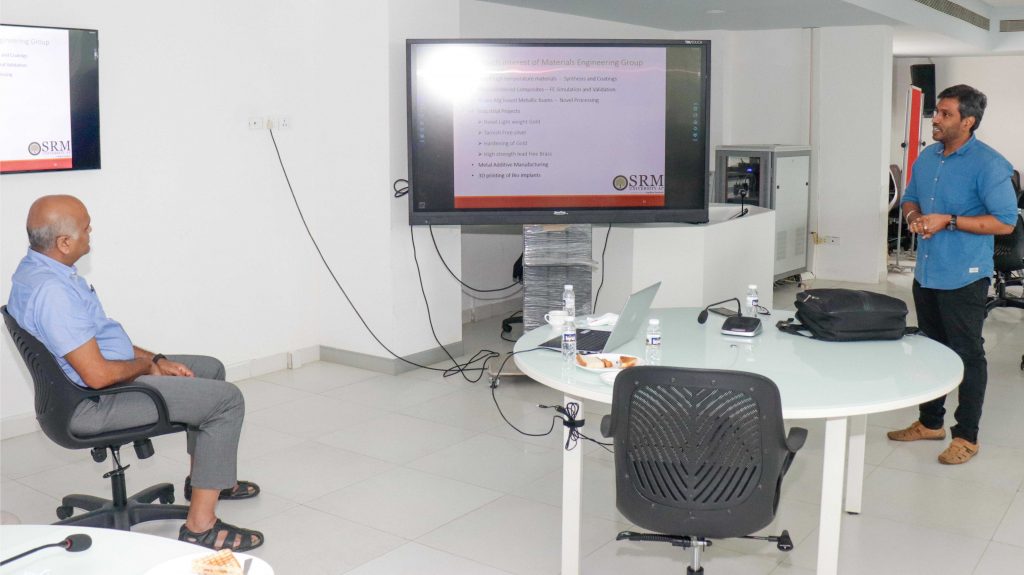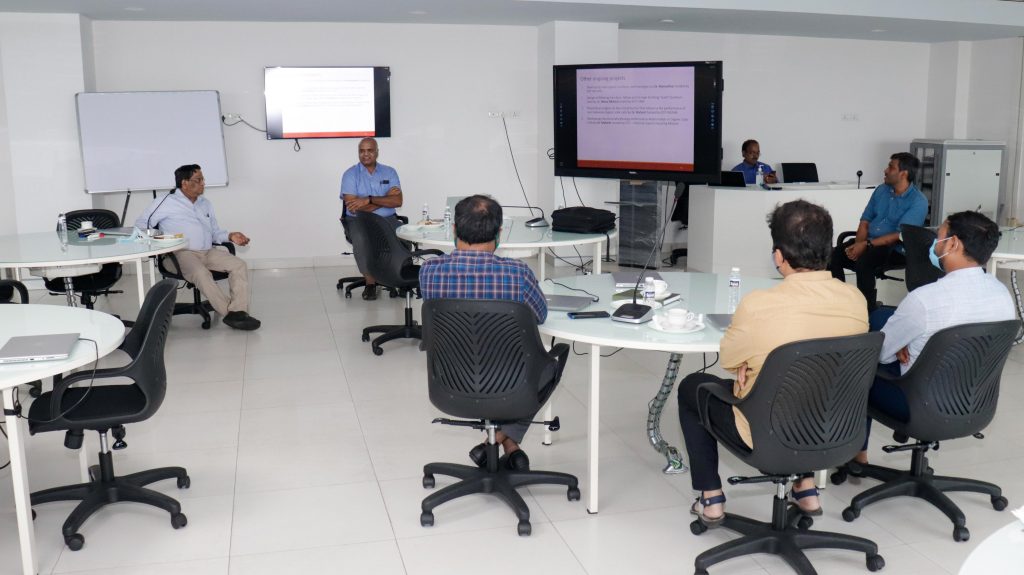Research News
- SRM University-AP develops sustainable transparent “biofilm” to replace plastic cuvettes September 21, 2021
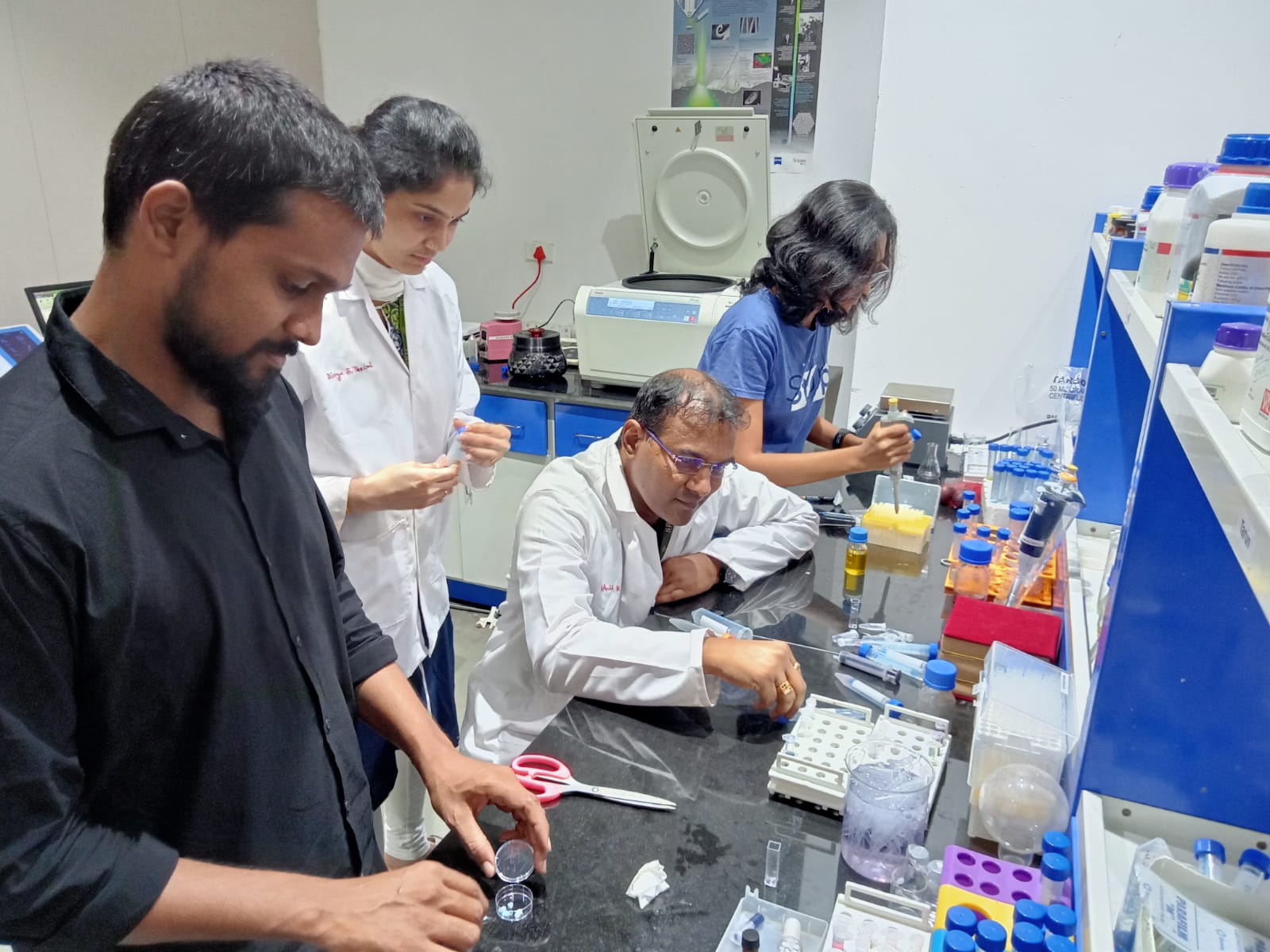 Dr Anil K Suresh, Associate Professor, Department of Biological Sciences, and his team from SRM University-AP recently developed a see-through transparent (with 85% above transmittance) biotemplate which they derived from the fish scale wastes to substitute the extensive usage of eco-unfriendly disposal plastic cuvettes for UV-Visible Spectroscopy measurements in the spectrum of 350-900 nm. UV-Vis spectroscopy is a versatile analytical tool used to examine the nature of various synthetic, biological and clinical molecules for pharmaceutical and environmental applications. The team members demonstrated the practical on-biotemplate analysis of diverse analytes such as DNA, proteins, nanoparticles, organic dyes, bacteria, BSA assay and dye-degradations.
Dr Anil K Suresh, Associate Professor, Department of Biological Sciences, and his team from SRM University-AP recently developed a see-through transparent (with 85% above transmittance) biotemplate which they derived from the fish scale wastes to substitute the extensive usage of eco-unfriendly disposal plastic cuvettes for UV-Visible Spectroscopy measurements in the spectrum of 350-900 nm. UV-Vis spectroscopy is a versatile analytical tool used to examine the nature of various synthetic, biological and clinical molecules for pharmaceutical and environmental applications. The team members demonstrated the practical on-biotemplate analysis of diverse analytes such as DNA, proteins, nanoparticles, organic dyes, bacteria, BSA assay and dye-degradations.Dr Anil claims that the large-scale development of the biotemplate can resolve several issues in performing sustainable research; for instance, generates huge demand for fish scales as a resource stratagem otherwise causative of foul smell and disease propagation when discarded. Second, the use of non-biodegradable plastic cuvettes can be minimized for routine analytics and third, unlike plastic cuvettes that demand 500-fold analyte our biotemplate allows the analysis at a very low 10 microlitre volumes, making it feasible to analyse expensive, rare, and high-risk analytes. Dr Anil K Suresh owns the copyrights for this pathbreaking invention by being granted an Indian patent. This work is accepted for publication in the prestigious Journal of “Green Chemistry” by the Royal Society of Chemistry. Read the full paper here.
Adding to the mechanistic, Dr Anil said, “naturally acquired droplet retaining ability for over 30 minutes against gravity while vertically positioning the biotemplate supported such ultra-low volume measurements and monitoring of chemical reactions in-situ”. Interestingly, the same ability allows the retrieval of the analytes after completion of the analysis, crucial for precious analytes. Dr Anil says the best part is that the transparent biotemplate can be discarded back into the environment post-usage without any hesitation as the biotemplate is completely biodegradable.
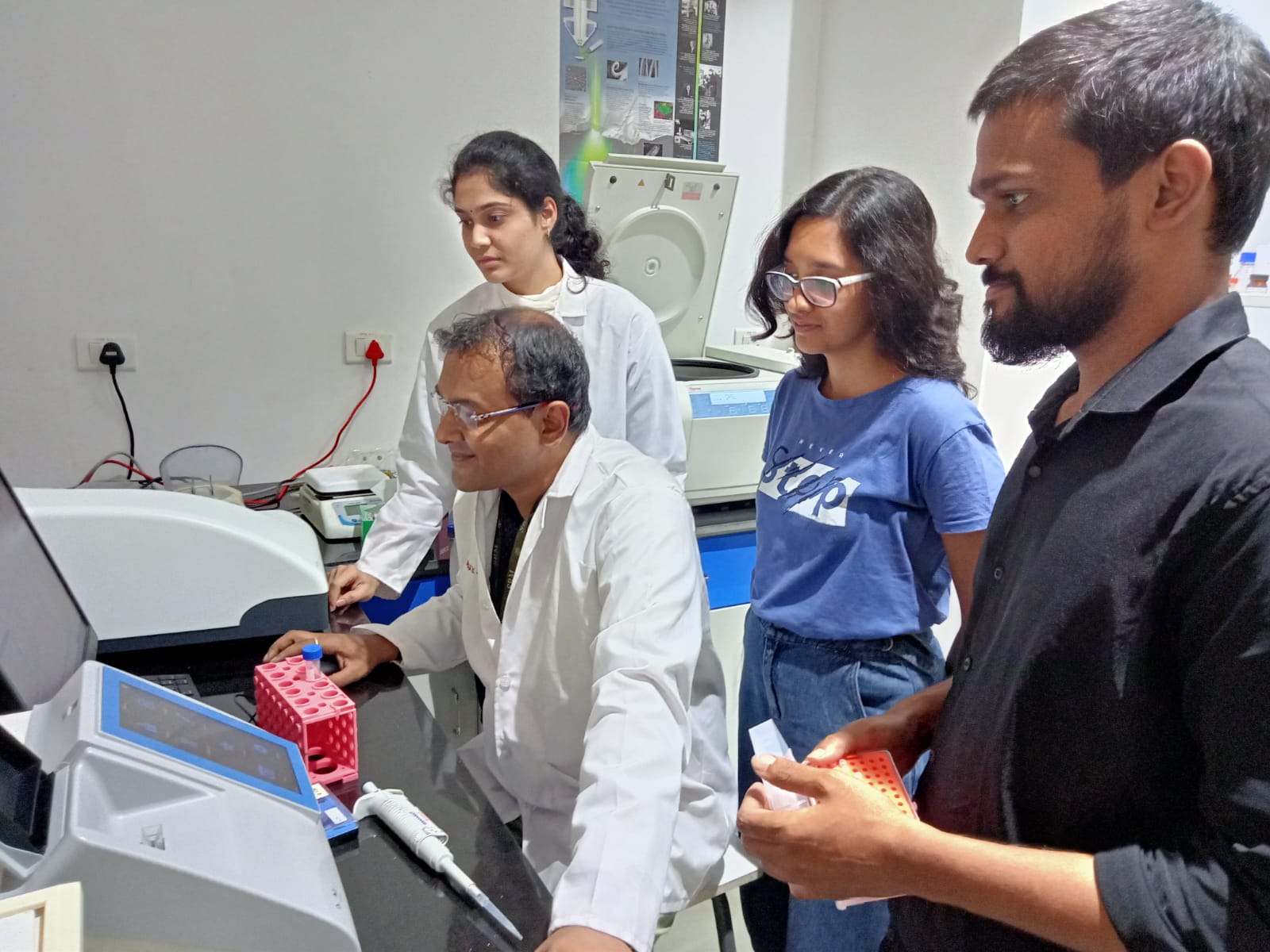
Further, the research group demonstrated ease in large-scale production by generating ~3000 bio templates at an affordable price. Dr Anil emphasised that this low-cost, plastic-free, use-and-throw biodegradable transparent biotemplate stemmed from food waste as a bioresource stratagem has huge potential in routine scientific and pharma UV-Vis analytics and he will very soon bring this product to the scientific community as a sustainable science solution.
Dr Anil Suresh concluded that this breakthrough conception would not have been possible without the rigorous efforts of his team and the continuous support from the university management, who are also encouraging and willing to support Dr Anil to establish his own start-up within the University. Dr Anil Suresh thanked his group members Ms Divya Parimi, Mr Chandra Bhatt, Mr Tharun Bollu and Ms Madhura, his collaborators Dr Malli and Mr Jacob. Dr Anil’s team especially thanked the management of SRM University-AP; the President Dr P. Sathyanarayanan for his generous support, Prof D Narayana Rao, Pro-Vice-Chancellor for his constant untiring encouragement, motivation and support in all his scientific endeavours, and the Vice-Chancellor Prof V S Rao for his kind support.
Continue reading → - Third year CSE students innovate efficient plastic recycling technology September 17, 2021
 Swikriti Khadke, Pragya Gupta, and Shanmukh Rachakunta from third-year Computer Science Engineering have published a research paper titled “Efficient Plastic Recycling and Remold Circular Economy using the Technology of Trust – Blockchain” along with their mentors from SRM University-AP Dr Jatindra Kumar Dash, Dr Goutam Kumar Dalapati and Dr Sabyasachi Chakrabortty in the peer-reviewed journal Sustainability.
Swikriti Khadke, Pragya Gupta, and Shanmukh Rachakunta from third-year Computer Science Engineering have published a research paper titled “Efficient Plastic Recycling and Remold Circular Economy using the Technology of Trust – Blockchain” along with their mentors from SRM University-AP Dr Jatindra Kumar Dash, Dr Goutam Kumar Dalapati and Dr Sabyasachi Chakrabortty in the peer-reviewed journal Sustainability.Global plastic waste is increasing rapidly. The strategic management of plastic waste and recycling can preserve environmental species and associated costs. The utilization of plastic can be done by introducing Blockchain during plastic waste recycling. Automation for the segregation and collection of plastic waste can effectively establish a globally recognizable tool using Blockchain-based applications. Collection and sorting of plastic recycling are feasible by keeping track of plastic with unique codes or digital badges throughout the supply chain. Efficient recycling technology is essential to reduce plastic pollution. Many technologies have been employed to enhance plastic recycling. Among them, blockchain is promising for plastic recycling and circular economy (CE). Blockchain, a distributed ledger, consists of some ordered blocks which are unchangeable. This can be considered an exemplary way to push the transactions of their customers under the same blockchain technology. The research group used machine learning techniques to predict plastic generation globally so that they could see the impact it will make in the coming future. The students have used ARIMA – Auto-Regressive Integrated Moving Average for the study.
The potential idea is to utilize an approach wherein recyclers can keep track of generated waste as it moves through the various chains. A platform that works by tracking recycling activities across a local recycling supply chain on the Blockchain. When this will be publicly available, consumers can also use the ledger info to make more informed purchasing decisions. The Blockchain can be utilized to track individual items through the recycling supply chain by creating physical markers like QR codes.
The suggested Blockchain-based platform can be implemented in various nations with an autonomous waste collector and storage system. This process can be expanded to individual collectors and storage systems. The novel process will be created by incorporating a reward-based Blockchain scheme with the collaboration of global businesses and local waste collectors. The proposed model further allows the effective sharing of databases among various supply chains to create a CE.
Talking about the social implications of the research, the students firmly believe that the study will result in the introduction of new technology in the recycling industry and promote awareness about technology in rural areas. Developing a platform and implementing blockchain and other facilities will be the focus of these young innovative brains of SRM University-AP in the forthcoming days.
Read the full paper here: https://doi.org/10.3390/su13169142
Continue reading → - Research scholar gets prestigious scholarship from IRRI September 16, 2021
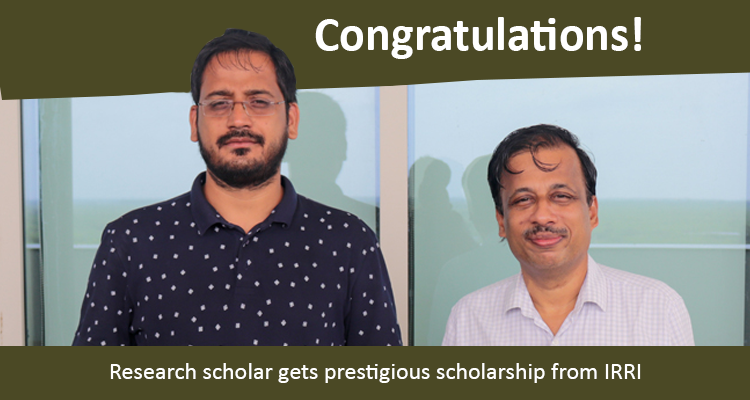 A Doctor of Philosophy (PhD) student of the Department of Biological Sciences at SRM University-AP, Andhra Pradesh, Faraz Azeem, has been awarded a prestigious scholarship by the International Rice Research Institute (IRRI), Manila, Philippines. The scholarship will enable Faraz to carry out a part of his PhD research under the supervision of Dr Jauhar Ali, Senior Scientist-II, Head – Hybrid Rice Development Consortium (HRDC), Leader – Hybrid Rice Breeding Cluster, Rice Breeding Platform, International Rice Research Institute, Los Banos, Philippines, for a period of one year and four months.
A Doctor of Philosophy (PhD) student of the Department of Biological Sciences at SRM University-AP, Andhra Pradesh, Faraz Azeem, has been awarded a prestigious scholarship by the International Rice Research Institute (IRRI), Manila, Philippines. The scholarship will enable Faraz to carry out a part of his PhD research under the supervision of Dr Jauhar Ali, Senior Scientist-II, Head – Hybrid Rice Development Consortium (HRDC), Leader – Hybrid Rice Breeding Cluster, Rice Breeding Platform, International Rice Research Institute, Los Banos, Philippines, for a period of one year and four months.Faraz joined SRM University-AP, Andhra Pradesh, in January 2021 and is working on “Understanding the genetics and molecular biology of nitrogen-use efficiency in rice” under the guidance of Prof Jayaseelan Murugaiyan, HoD, Department of Biological Sciences, SRM University-AP. Dr P Sathyanarayanan, President; Prof V S Rao, Vice-Chancellor; Prof D Narayana Rao, Pro-Vice-Chancellor of SRM University-AP congratulated Faraz for this accomplishment.
The International Rice Research Institute (IRRI) is a global agricultural research and training organisation with offices in seventeen countries and headquarters in Los Banos, Laguna, Philippines. IRRI is well-known for its role in producing rice varieties that contributed to the 1960s Green Revolution, which helped Asia avoid famine. The CGIAR Consortium of International Agricultural Research Centres, a global alliance of institutions involved in food security research, includes 15 agricultural research centres worldwide. The International Rice Research Institute (IRRI) is one of the Asia’s largest non-profit agricultural research facility.
SRM University-AP provides a wide array of opportunities and benefits along with its PhD Programmes. The nascent university has more than 150 PhD students to date in various departments of Engineering, Science, Liberal Arts, Business Administration and Social Sciences. SRM University-AP university has a vibrant research environment with state-of-the-art facilities along with attractive fellowship and complimentary food and accommodation at the university campus. The faculty advisers have paramount knowledge and experience in research along with international exposure. The university also provides support for journal publications, patent filing, and attending national and international conferences.
SRM University-AP further has MoUs with reputed universities abroad for Student Exchange Programme. In addition, the university is conducting research projects funded by prominent organisations, industries and the Government of India. Research projects sponsored by DST, DST-NSM, DBT, DBT-Wellcome Trust, UGC-DAE, ARBL, Titan industries etc are a few of the current ongoing projects.
Continue reading → - Simple and portable spectrochemical probe for rapid detection of chlorides ions in water September 8, 2021
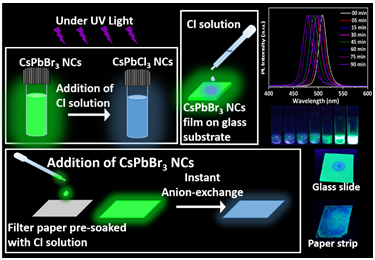 Dr Nimai Mishra, Assistant Professor, Department of Chemistry, SRM University-AP, Andhra Pradesh, along with his research group comprising of students pursuing PhD under him, Ms V.G.Vasavi Dutt and Mr Syed Akhil has published a research article titled Cesium Lead Bromide Perovskite Nanocrystals as a Simple and Portable Spectrochemical Probe for Rapid Detection of Chlorides in the Journal ChemistrySelect (Publisher: Wiley-VCH on behalf of Chemistry Europe, Impact Factor-2.2).
Dr Nimai Mishra, Assistant Professor, Department of Chemistry, SRM University-AP, Andhra Pradesh, along with his research group comprising of students pursuing PhD under him, Ms V.G.Vasavi Dutt and Mr Syed Akhil has published a research article titled Cesium Lead Bromide Perovskite Nanocrystals as a Simple and Portable Spectrochemical Probe for Rapid Detection of Chlorides in the Journal ChemistrySelect (Publisher: Wiley-VCH on behalf of Chemistry Europe, Impact Factor-2.2).Chloride anions are widely abundant in water and when they combine with calcium, potassium, and magnesium, they form chloride salts. However, the higher concentrations badly affect the environment by causing severe dehydration and even plant death. High concentrations of sodium chloride exhibit the potential of corrosive damage thereby releasing toxic metals from plumbing fixtures. Hence, there is a need to monitor the concentration levels of chloride salts in water. Several techniques like titration, spectrophotometry, ion chromatography, electrochemistry, etc have been reported to date. Despite the high accuracy and precision of these techniques, they involve expensive instrumentation and is out of reach from on-site detection. Hence, it is necessary to look for simple, portable, and cost-effective strategies for the detection of chlorides in the water.
In this article, Dr Mishra’s research group demonstrated that the wide spectral tunability of CsPbBr3 perovskite nanocrystals (NCs) via instantaneous and facile anion exchange, make them a suitable candidate for chloride detection. Rapid anion-exchange processes between CsPbBr3 perovskite NCs and different chloride solutions were carried out in ambient conditions. The resultant anion-exchanged CsPbCl3-xBrx NCs preserved the structural properties and exhibited a remarkable blue shift in photoluminescence spectra. This forms a basis for the detection of chloride ions in water. This has been applied with the limit of detection up to 100 µM. The detection strategies were not only limited to the direct addition of chloride solutions to NCs, but they also showed a visual colour change under UV light when the chloride solution is drop-casted on CsPbBr3 films that are deposited on glass substrates. Furthermore, the detection strategy is established by drop-casting CsPbBr3 NCs onto paper strips that are pre-soaked in chloride solutions. A considerable blue shift in fluorimetry proves them to be an excellent sensing medium as practical spectrochemical probes for on-site detection of chlorides. Based on this, a colour chart and selectivity chart to access the presence of chlorides and their concentration is also demonstrated.
Continue reading → - Prof U Ramamurty, renowned researcher from NTU Singapore, visits SRM University-AP September 7, 2021
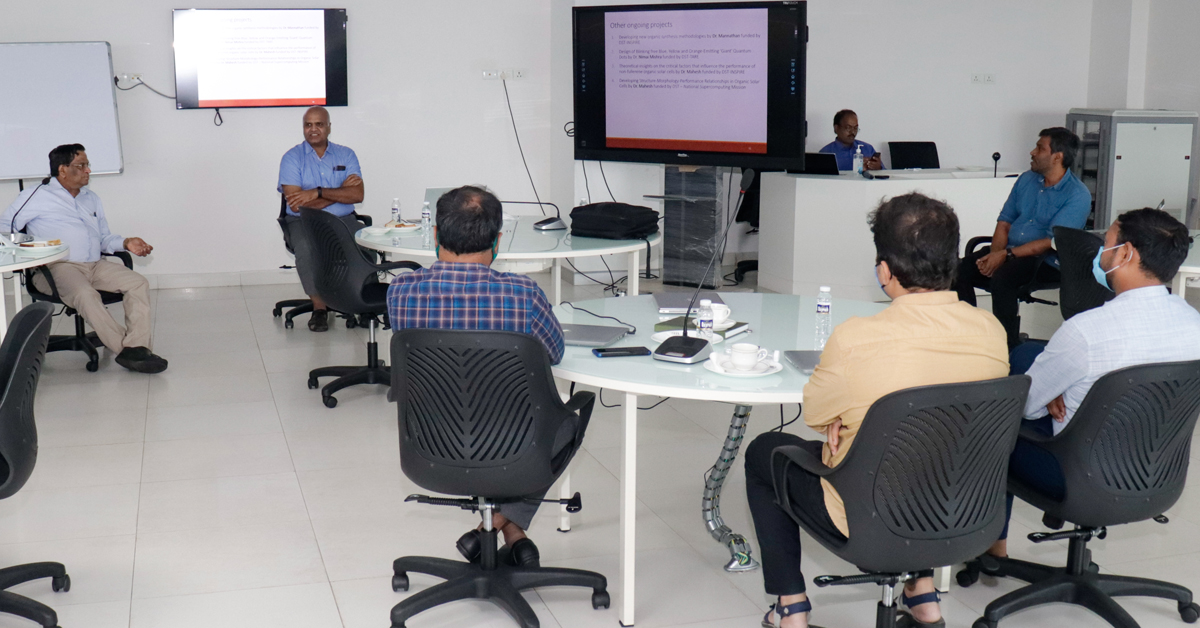 An interactive session between Prof U Ramamurty, President Chair Professor, School of Mechanical & Aerospace Engineering at Nanyang Technological University (NTU), Singapore, and the faculty members of SRM University – AP, Andhra-Pradesh was held on Monday.
An interactive session between Prof U Ramamurty, President Chair Professor, School of Mechanical & Aerospace Engineering at Nanyang Technological University (NTU), Singapore, and the faculty members of SRM University – AP, Andhra-Pradesh was held on Monday.During the discussion, Prof Ramamurty emphasized the importance of research collaboration between faculty members from different research areas and about utilizing expertise to achieve significant scientific output.
Dr Pardhasaradhi Maram from the Department of Chemistry, Dr Sabyasachi Mukhopadhyay from the Department of Physics, and Prof G S Vinod Kumar from the Department of Mechanical Engineering presented their detailed research areas that focus on storage devices, catalysts for value-added products, energy and sensing devices, novel metallic materials, additive manufacturing of metals and Bio-implants, and industry collaborative research work.
Prof Ramamurty said that he is glad to see that productive science is being done at SRM University-AP. “Given that the University has started only 4 years ago and been functioning amidst a pandemic for more than one and a half years, the progress in research is significant and very impressive. Interdisciplinary efforts between various departments in the University will give effective results”, he added.
Prof D Narayana Rao, Pro-Vice-Chancellor, SRM University – AP expressed his interest in establishing NTU – SRM joint Centre for Advanced Research in functional and structural materials at SRM University campus to Prof Ramamurty. The centre that Prof Rao envisions will provide an opportunity to synergize the expertise and resources of NTU, Singapore, and SRM University – AP to carry out front-line research in the areas of novel materials, self-healing materials and also additive manufacturing (3D Printing of metals and bio-implants).
Continue reading → - Cost-effective electro-catalyst for oxygen reduction reaction September 6, 2021
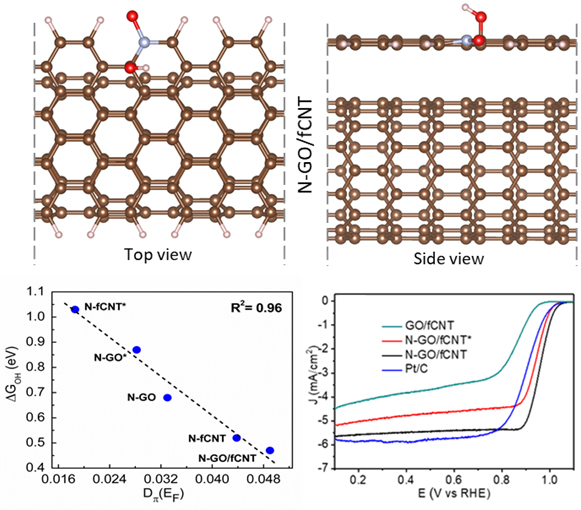 A research paper titled “Nitrogen doping derived bridging of Graphene and Carbon Nanotube composite for oxygen electroreduction” has been published by Prof Ranjit Thapa, Professor of Physics, SRM University – AP, as a co-author, in International Journal of Energy Research, having Impact Factor of 5.164.
A research paper titled “Nitrogen doping derived bridging of Graphene and Carbon Nanotube composite for oxygen electroreduction” has been published by Prof Ranjit Thapa, Professor of Physics, SRM University – AP, as a co-author, in International Journal of Energy Research, having Impact Factor of 5.164.In this work, the research group investigated the origin of high catalytic activity of oxidic-N configuration in nitrogen-doped CNT and graphene heterostructure using density functional theory (DFT). We have plotted the free energy profile of the oxygen reduction reaction (ORR) to estimate the thermodynamic overpotential and catalytic performance of the respective active sites. The overpotential is related to the quantifying parameter ∆GOH (with R2 = 0.98) and the π electron density at the Fermi level, defined as an electronic descriptor, which is highly correlated with the ∆GOH with R2 value 0.96. For various N doped configurations, we correlated the ∆GOH values with π electron density at the Fermi level and found that the carbon site adjacent to the oxide-N configuration is a more prominent site for ORR. Further, we show that the oxidic-N configuration in the heterostructure of graphene and CNT is the ideal configuration, which gives a lower overpotential of 0.54 eV for ORR on adjacent carbon sites. Therefore, the charge transfer occurs from underneath CNT to graphene and increases the value of π electron density at the Fermi level which leads to the higher catalytic performance of the active site.
In the early 20th century, fuel cells were invented and their global impact has not reached up to its regular commercialization when compared with battery technology. The fuel cell device could be a powerful technique to generate electricity for large energy demand without greenhouse gas emissions. However, other major hurdles in the commercialization of fuel cell devices are the cost of platinum (as a catalyst), its poisoning and stability. Recently, carbon-based materials such as graphene, carbon nanotubes and activated carbon have been evolved as metal-free low-cost catalysts due to their (i) high abundance/yield (ii) reactivity towards oxygen just by introducing impurities like heteroatoms or other metals. However, identifying an efficient design principle to search optimal doping configurations in various carbon systems is a grand challenge for researchers.
This work is done in collaboration with Research Institute, SRM Institute of Science & Technology, Kattankulathur-603203, Chennai (India).
In future, the study aims to propose the effective design principle for various doped carbon systems as a catalyst to identify the optimal active sites and configurations for ORR. The role of π orbital in carbon systems such as graphene, graphene nanoribbons, carbon nanotube, etc is very important and can be a general electronic descriptor to define catalytic activity. Also, π electron descriptors and machine learning algorithms based combined approach can boost the search for ideal carbon catalyst for ORR with low DFT cost.
Read the full paper here: https://doi.org/10.1002/er.7179
Continue reading → - CRIDAP appoints Dr Ghanshyam Pandey as an expert for agriculture September 3, 2021
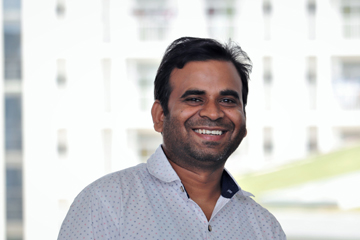 Dr Ghanshyam Pandey, Assistant Professor of Economics, SRM University – AP has been appointed as an expert for agriculture, rural development, livelihood issues, and climate change and agriculture by The Centre of Integrated Rural Development for Asia and Pacific (CRIDAP). CRIDAP is an intergovernmental and autonomous organization and has 15 member countries. The member countries are Afghanistan, Bangladesh, Fiji, India, Indonesia, Iran, Lao PDR, Malaysia, Myanmar, Nepal, Pakistan, Philippines, Sri Lanka, Thailand, and Vietnam. His tenure of appointment will be up to 2024.
Dr Ghanshyam Pandey, Assistant Professor of Economics, SRM University – AP has been appointed as an expert for agriculture, rural development, livelihood issues, and climate change and agriculture by The Centre of Integrated Rural Development for Asia and Pacific (CRIDAP). CRIDAP is an intergovernmental and autonomous organization and has 15 member countries. The member countries are Afghanistan, Bangladesh, Fiji, India, Indonesia, Iran, Lao PDR, Malaysia, Myanmar, Nepal, Pakistan, Philippines, Sri Lanka, Thailand, and Vietnam. His tenure of appointment will be up to 2024.Dr Ghanshyam Pandey’s role in the organisation:
- CIRDAP resource person to participate in project proposal development and consultancy.
- CIRDAP resource person for flagship training courses.
- Reviewer of Asia-Pacific Journal on Rural Development (APJORD).
- Part of CIRDAP Think Tank for knowledge sharing and solutions to IRD and PA.
- To expand CIRDAP Think Tank Networks.
- To advise on refining CIRDAP Strategic Plan 2020-2024.
About the organisation:
Continue reading →
The Centre on Integrated Rural Development for Asia and the Pacific (CIRDAP) is a regional, intergovernmental and autonomous organisation. It was established on 6 July 1979 at the initiative of the countries of the Asia-Pacific region and the Food and Agriculture Organization (FAO) of the United Nations with support from several other UN bodies and donors. The Centre came into being to meet the felt needs of the developing countries at that time as an institution for promoting integrated rural development in the region. From the original six members, CIRDAP has now grown up as a Centre of 15 member countries. The member countries are Afghanistan, Bangladesh (Host State), Fiji, India, Indonesia, Iran, Lao PDR, Malaysia, Myanmar, Nepal, Pakistan, Philippines, Sri Lanka, Thailand and Vietnam. Operating through designated contact ministries and link institutions in member countries, CIRDAP promotes regional cooperation. It plays a supplementary and reinforcing role in supporting and furthering the effectiveness of integrated rural development programmes in Asia and the Pacific. - First patent granted to SRM University-AP September 1, 2021
Title of the Patent: A Process for Preparing Magnesium Foams
Patent applicant: SRM University-AP, Andhra Pradesh
Patent Application number: 202041001715
Date of Filing: 14/01/2020
Date of Publication: 24/01/2020
Date of Grant: 16/08/2021
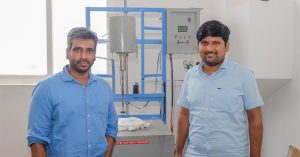 Prof G S Vinod Kumar and his PhD Scholar Mr Dipak Nandkumar Bhosale from the Department of Mechanical Engineering has brought the first granted patent to SRM University-AP. The patent titled “A Process for Preparing Magnesium Foams” is on the novel processing of Magnesium alloy foams via molten metal route. Metal foams are the class of novel ultra-lightweight and high strength materials used for engineering structures. Under the light-alloy category, Magnesium alloys possess greater challenges to foam and the inventors Mr Dipak Bhosale, PhD scholar and Prof Vinod Kumar (PhD supervisor) of Dept. of Mechanical Engineering have come up with a novel process to foam Magnesium alloy effectively. The patent was filed on January 14, 2020, and granted on August 16, 2021. It is indeed commendable that the patent grant is obtained in just 16 months from the date of application.
Prof G S Vinod Kumar and his PhD Scholar Mr Dipak Nandkumar Bhosale from the Department of Mechanical Engineering has brought the first granted patent to SRM University-AP. The patent titled “A Process for Preparing Magnesium Foams” is on the novel processing of Magnesium alloy foams via molten metal route. Metal foams are the class of novel ultra-lightweight and high strength materials used for engineering structures. Under the light-alloy category, Magnesium alloys possess greater challenges to foam and the inventors Mr Dipak Bhosale, PhD scholar and Prof Vinod Kumar (PhD supervisor) of Dept. of Mechanical Engineering have come up with a novel process to foam Magnesium alloy effectively. The patent was filed on January 14, 2020, and granted on August 16, 2021. It is indeed commendable that the patent grant is obtained in just 16 months from the date of application.Metal foam is a cellular structure consists of solid metal with gas-filled pores. The pores can be sealed (closed-cell foam) or interconnected (open-cell foam). The present patent relates to a process for the preparation of closed-cell Magnesium foams using dolomite [CaMg (CO3)2] as a blowing agent (gas source), through a liquid metal route. The inventors have demonstrated economical and naturally occurring mineral dolomite to be an effective blowing agent for preparing magnesium foams and in-situ formed MgAl2O4 (spinel) particles as the stabilizing agent during stabilization of foams. The Magnesium foams produced by the process of the present disclosure have a good expansion, lower density, uniform pore size distribution and polyhedral pore structure. Through the present process Magnesium foams with 88% porosity 0.20 g/cm3 foam density was obtained. Magnesium foam is an attractive material that exhibits a unique combination of mechanical, physical, thermal, electrical and acoustic properties. It has high strength to weight ratio, good compressive strength and high energy/shock/vibration/sound absorption efficiency. Owing to these properties the magnesium foam finds potential in lightweight structural applications, sound-absorbing, energy and vibration and shock damping application.
Continue reading → - Resource and network-aware data placement algorithm for periodic workloads in cloud August 26, 2021
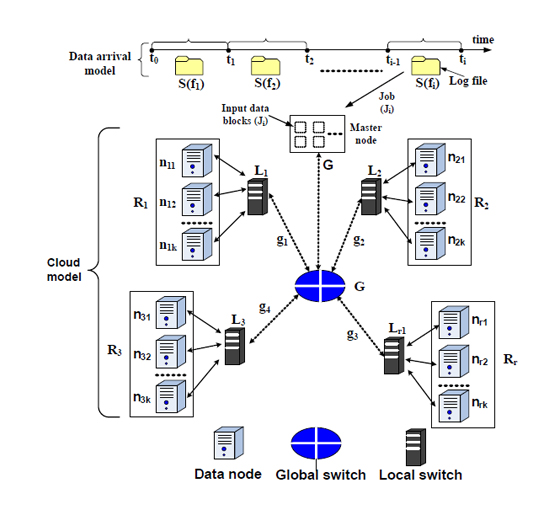 Dr Hirenkumar Thakkar from the Department of Computer Science and Engineering has published a research paper titled “RENDA: Resource and Network-aware Data Placement Algorithm for Periodic Workloads in Cloud” in the journal IEEE Transactions on Parallel and Distributed Systems Vol. 32, No. 12, pp. 2906-2920.
Dr Hirenkumar Thakkar from the Department of Computer Science and Engineering has published a research paper titled “RENDA: Resource and Network-aware Data Placement Algorithm for Periodic Workloads in Cloud” in the journal IEEE Transactions on Parallel and Distributed Systems Vol. 32, No. 12, pp. 2906-2920.Each year, tech giants are spending millions of dollars to purchase the resources to store the data. However, efficient data placement is a critical issue for companies that experience several terabytes of data generation on daily basis. With such speed of data generation, it is the need of the hour to come up with a strategy for an efficient storage mechanism. This research investigates the data placement problems in cloud data centres and assists several tech giants such as Google, Facebook etc., to manage the cloud resource properly.
This research benefits society with a lower cost of cloud subscriptions, as tech giants are able to save several thousands of dollars by means of an efficient storage mechanism. This ultimately enables the tech giants to offer cloud service subscriptions at a reasonable cost.
The study was carried out in collaborations with Artificial Intelligence and Big Data Computing Lab (ABC Lab), Chang Gung University, Taiwan with Prof. Prasan Kumar Sahoo and in collaboration with Prof. Bharadwaj Veeravalli from the National University of Singapore. In addition to the current collaboration, there are several collaborations with the Indian Institute of Technology (IIT-BHU) as well as the University of Tartu, Estonia.
In future, Dr Thakkar is planning to come up with a book on cloud resource management using Nature-inspired learning. In addition to that, there are few projects such as filing two separate patents on Healthcare data analysis and opinion feature mining in collaboration with Chang Gung University, Taiwan, the National University of Singapore, and the University of Tartu, Estonia.
Read the full paper here: https://doi.org/10.1109/TPDS.2021.3080582
Continue reading → - SRM University-AP observes Research Day to promote research among students August 21, 2021
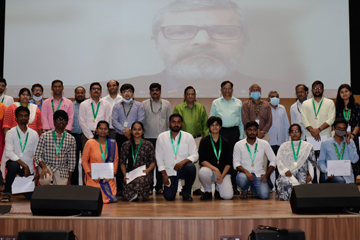 The third edition of Research Day was held at SRM University-AP on August 21, 2021, to provide an excellent opportunity for all the faculty members, research scholars and students to exchange and exhibit their ideas on research. Prof U B Desai, Chancellor, Anurag University-Hyderabad, was the Chief Guest of the event.
The third edition of Research Day was held at SRM University-AP on August 21, 2021, to provide an excellent opportunity for all the faculty members, research scholars and students to exchange and exhibit their ideas on research. Prof U B Desai, Chancellor, Anurag University-Hyderabad, was the Chief Guest of the event.In his speech, Prof UB Desai admitted that creating a research ecosystem in education has truly become important. During the last decade, the realisation happened, and it has been reflected in the National Education Policy, yet there is a long way to go. He further congratulated SRM University-AP for dedicating a day for research to motivate students towards the research pursuits. In his keynote address, “India’s Ascent to 5G”, he discussed some pertinent queries and showed the way forward. In every 10 years, there is an evolution in Communications. He made the audience aware of the 10 key technological trends- Artificial Intelligence, Autonomous Networks, Cyber Security, Distributed Ledgers, Dynamic Data, Extended Reality, Internet of Things, Quantum Computing, Autonomous Systems along with 3 software trends- Softwarization, Cloudification, Virtualisation which will shape the digital future. He further explained how Network evolution beyond the currently planned 5G is taking place. Research on 6G has already started, and in the future, it is poised to dominate 5G.
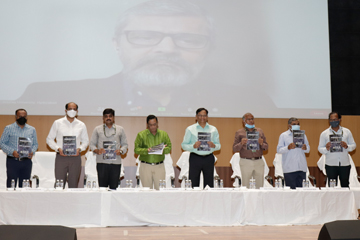 Prof Desai pointed out that India can make much improvement in Edge Computing and Metadata as these domains do not require huge resources. He further delved into the Evolved Network architecture and Indian Scenario and thrusts. He expressed that Research on 5G, Internet of Things and Cyber Security is critical to the National Interests. The nation thus is enhancing current Research and Developmental capabilities- domestic manufacturing and export-oriented. With interesting facts and charts, he laid down the mobile communication roadmap in India. In our country, mobile broadband is the premium source of the internet, with 80% of the internet traffic generated by it. An Indian consumes 11 Gb data per month per smartphone on an average which is the highest in the world. It need not be overemphasized that there is huge scope and opportunities in 5G research and beyond. Similarly, the Internet of Things is going to be another big wave. The next-generation devices and appliances will be hugely IoT based with less hassle in operation. Smart Cities-Sensors, Precision Agriculture, Digital Health, Industry 4.0, Automative are some of the sectors where it has substantial scope for application. Indian operators are also to launch nationwide NB-IoT services in the coming days.
Prof Desai pointed out that India can make much improvement in Edge Computing and Metadata as these domains do not require huge resources. He further delved into the Evolved Network architecture and Indian Scenario and thrusts. He expressed that Research on 5G, Internet of Things and Cyber Security is critical to the National Interests. The nation thus is enhancing current Research and Developmental capabilities- domestic manufacturing and export-oriented. With interesting facts and charts, he laid down the mobile communication roadmap in India. In our country, mobile broadband is the premium source of the internet, with 80% of the internet traffic generated by it. An Indian consumes 11 Gb data per month per smartphone on an average which is the highest in the world. It need not be overemphasized that there is huge scope and opportunities in 5G research and beyond. Similarly, the Internet of Things is going to be another big wave. The next-generation devices and appliances will be hugely IoT based with less hassle in operation. Smart Cities-Sensors, Precision Agriculture, Digital Health, Industry 4.0, Automative are some of the sectors where it has substantial scope for application. Indian operators are also to launch nationwide NB-IoT services in the coming days.In his welcome speech, Prof D. Narayana Rao, Pro-Vice-Chancellor, SRM University-AP, said that the universities and educational institutes need to trigger the thought process and inquisitiveness among the students beyond the classroom. Universities should give top priorities for research that creates a positive impact or change in society. The country’s universities and educational institutions need to be encouraged to perform transactional research that leads to the development of products needed for societal development. Universities and educational institutes should also look for collaborative research with the industry. Universities are the creators of knowledge and innovative ideas, providers of skilled manpower, agents of societal changes and symbols of international attention and prestige. Therefore rather than counting the number of publications, more focus is to be given to translational research.
Universities and educational institutes need to synergise so that both of them can be benefitted from the collaborative research outcomes. Falling behind innovation would mean falling behind in becoming a world leader. Therefore, for a country like India, aspiring to attain global economic leadership needs to be strongly encouraged and supported in research. Sri Narendra Modi, our Hon’ble Prime Minister, firmly believes that our future will be secure and global leadership will sustain only when we produce the next generation of world-class scientists, technologists, researchers and innovators. As India emerges as a global power, we need to move forward from being a knowledge consumer to a knowledge producer. It is the responsibility of universities and educational institutes to create knowledge.
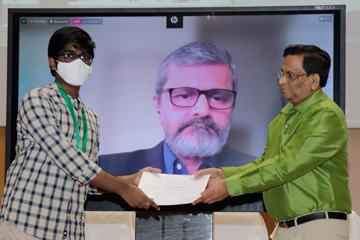 SRM University-AP provides abundant opportunities to faculty and students to carry out frontline research. National Education Policy-2020’s sharp focus is on research and multidisciplinary approach. National Research Foundation has been set up as per the recommendation of National Education Policy-2020 to significantly enhance the research contributions. Research is the way forward to be a world superpower. We must inculcate the desire to perform quality research in students even from the undergraduate days.
SRM University-AP provides abundant opportunities to faculty and students to carry out frontline research. National Education Policy-2020’s sharp focus is on research and multidisciplinary approach. National Research Foundation has been set up as per the recommendation of National Education Policy-2020 to significantly enhance the research contributions. Research is the way forward to be a world superpower. We must inculcate the desire to perform quality research in students even from the undergraduate days.In his speech, Prof V S Rao asserted how the nascent university has created its reputation in the education world of India. In fact, SRM University-AP has achieved several marvels in the last 30 months, including many research publications, projects, and several patents. Since its inception in 2017, the university has published over 500+ papers, 22 patents and 36 funded projects with an outlay of about Rs. 20 crores. He further emphasised that, unlike several other universities, SRM University-AP has research embedded in the curriculum. SRM University-AP does not believe in keeping research outside the curriculum. The capstone projects, research based learning, undergraduate research project, research internships with international universities or industry-SRM University-AP offer a plethora of opportunities to the students to bring out the inner researcher among them.
SRM University-AP firmly believes that a research eco-system should be inculcated among the students. The students must learn how to think and question and how to find the answers. Agreeing with Prof D. Narayana Rao, Prof VS Rao also mentioned that the National Education Policy-2020 puts a great emphasis on research since the importance of research need not be debated today. SRM University-AP thus introduced Research Day to impart curiosity towards transcendental knowledge among the students.
“Book of Abstracts” was launched by Prof V S Rao in the gracious presence of Prof UB Desai, Prof T Ragunathan, Associate Dean-Engineering, Prof Bandi Kamaiah, Dr B Siva Kumar, Deputy Dean and other dignitaries. 217 research abstracts were selected for presentation after review and scrutiny. 22 students out of them have received Gold medals for the research, and 9 students secured silver medals. All medal winners were felicitated in the event.
Continue reading →


